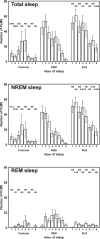Time structure analysis of leg movements during sleep in REM sleep behavior disorder
- PMID: 18246987
- PMCID: PMC2276132
- DOI: 10.1093/sleep/30.12.1779
Time structure analysis of leg movements during sleep in REM sleep behavior disorder
Abstract
Study objectives: To compare the time structure of leg movements (LM) during sleep of patients with rapid eye movement (REM) sleep behavior disorder (RBD) with that of patients with restless legs syndrome (RLS) or control subjects.
Design: The polysomnographically recorded tibialis anterior activity during sleep was analyzed by means of a new approach able to consider duration, intermovement interval, sleep stage and time of night distribution, and periodicity.
Patients and participants: Twenty patients with idiopathic RBD, 37 with idiopathic RLS and 14 age-matched control subjects were consecutively recruited.
Measurements and results: Most patients with RBD (85%) presented periodic leg movements during sleep (PLMS). PLMS occurred more frequently during non-REM sleep in patients with RLS and during REM sleep in patients with RBD. PLMS were shorter in duration, less often bilateral, and with a higher intermovement interval in patients with RBD compared to those with RLS. The number of PLMS decreased across the night in patients with RBD and in those with RLS, but not in control subjects. In all subjects, LM periodicity clearly depended on sleep state, with higher values during non-REM than during REM sleep. Patients with RBD showed a lower LM periodicity, compared with patients with RLS, in each of the sleep states.
Conclusions: Significant differences, together with some similarities in LM time structure, were observed between patients with RBD and those with RLS; for this reason, our approach seems to indicate that their phenotype might be dependent on 2 factors: disease and sleep stage.
Figures



Similar articles
-
Periodic leg movements in REM sleep behavior disorder and related autonomic and EEG activation.Neurology. 2002 Dec 24;59(12):1889-94. doi: 10.1212/01.wnl.0000038348.94399.f6. Neurology. 2002. PMID: 12499479 Clinical Trial.
-
Night-to-night variability of periodic leg movements during sleep in restless legs syndrome and periodic limb movement disorder: comparison between the periodicity index and the PLMS index.Sleep Med. 2013 Mar;14(3):293-6. doi: 10.1016/j.sleep.2012.08.014. Epub 2012 Oct 12. Sleep Med. 2013. PMID: 23068780 Clinical Trial.
-
Periodic Limb Movements During Sleep Mimicking REM Sleep Behavior Disorder: A New Form of Periodic Limb Movement Disorder.Sleep. 2017 Mar 1;40(3). doi: 10.1093/sleep/zsw063. Sleep. 2017. PMID: 28364416
-
Polysomnographic features of idiopathic restless legs syndrome: a systematic review and meta-analysis of 13 sleep parameters and 23 leg movement parameters.J Clin Sleep Med. 2022 Nov 1;18(11):2561-2575. doi: 10.5664/jcsm.10160. J Clin Sleep Med. 2022. PMID: 35903949 Free PMC article.
-
[Restless legs syndrome and periodic limb movements in sleep: clinical features, epidemiology, diagnosis].Neurol Neurochir Pol. 2002 Nov-Dec;36(6):1173-84. Neurol Neurochir Pol. 2002. PMID: 12715694 Review. Polish.
Cited by
-
New pathways and data on rapid eye movement sleep behaviour disorder in a rat model.Sleep Med. 2013 Aug;14(8):719-28. doi: 10.1016/j.sleep.2012.08.008. Epub 2012 Oct 9. Sleep Med. 2013. PMID: 23058690 Free PMC article.
-
Periodic limb movements in tetraplegia.J Spinal Cord Med. 2018 May;41(3):318-325. doi: 10.1080/10790268.2017.1320874. Epub 2017 May 2. J Spinal Cord Med. 2018. PMID: 28464758 Free PMC article.
-
Periodic limb movements during sleep: a narrative review.J Thorac Dis. 2021 Nov;13(11):6476-6494. doi: 10.21037/jtd-21-1353. J Thorac Dis. 2021. PMID: 34992826 Free PMC article. Review.
-
Diagnostic thresholds for quantitative REM sleep phasic burst duration, phasic and tonic muscle activity, and REM atonia index in REM sleep behavior disorder with and without comorbid obstructive sleep apnea.Sleep. 2014 Oct 1;37(10):1649-62. doi: 10.5665/sleep.4074. Sleep. 2014. PMID: 25197816 Free PMC article.
-
Respiratory-related leg movements and their relationship with periodic leg movements during sleep.Sleep. 2014 Mar 1;37(3):497-504. doi: 10.5665/sleep.3484. Sleep. 2014. PMID: 24587572 Free PMC article.
References
-
- Recording and scoring leg movements. The Atlas Task Force. Sleep. 1993;16:748–59. - PubMed
-
- Zucconi M, Ferri R, Allen R, et al. The official World Association of Sleep Medicine (WASM) standards for recording and scoring periodic leg movements in sleep (PLMS) and wakefulness (PLMW) developed in collaboration with a task force from the International Restless Legs Syndrome Study Group (IRLSSG) Sleep Med. 2006;7:175–83. - PubMed
-
- Sforza E, Juony C, Ibanez V. Time-dependent variation in cerebral and autonomic activity during periodic leg movements in sleep: implications for arousal mechanisms. Clin Neurophysiol. 2002;113:883–91. - PubMed
-
- Sforza E, Jouny C, Ibanez V. Time course of arousal response during periodic leg movements in patients with periodic leg movements and restless legs syndrome. Clin Neurophysiol. 2003;114:1116–24. - PubMed
-
- Winkelman JW. The evoked heart rate response to periodic leg movements of sleep. Sleep. 1999;22:575–80. - PubMed
MeSH terms
LinkOut - more resources
Full Text Sources
Medical

